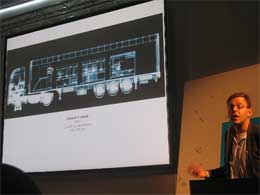 Yesterday was the presentation of the prize Winners in the brand new “Hybrid Art” category of Ars Electronica.
Yesterday was the presentation of the prize Winners in the brand new “Hybrid Art” category of Ars Electronica.
A superbly deadpan Wim Delvoye presented Cloaca (the name comes from the Latin word for sewer), a body of works that duplicate human digestion. The machine is fed and after a long process –involving wires, tubes but also acids, bacteria and enzyme liquids– produces feces. Since he started working on the project in 2000, Delvoye developed several models of Cloaca machines. The one on show is a domestic one, a Cloaca you could have at home.
When i first read that the machines had won an award of distinction, i was somewhat puzzled. Why give a prize to an installation that had toured art galleries? But it gradually made sense: as Jens Hauser, art curator, writer, and member of the jury noted a very “hybrid” characteristic of this piece is that it engages with different senses, particularly the smell.
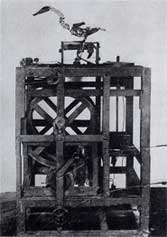 The work fuses kinetic with a very intimate human activity, involves various fields of expertise and plays with several layers of cultural meanings while referring to the history of art (Piero Manzoni´s Merda d´Artista) and robotics (Jacques de Vaucanson´s Digesting Duck). And after Delvoye´s presentation, i realized (once again) how much new media art needs confrontations with the “traditional” contemporary art sphere (and vice-versa.) But you´ve probably heard or read me on that one often enough so let´s proceed to Delvoye´s talk:
The work fuses kinetic with a very intimate human activity, involves various fields of expertise and plays with several layers of cultural meanings while referring to the history of art (Piero Manzoni´s Merda d´Artista) and robotics (Jacques de Vaucanson´s Digesting Duck). And after Delvoye´s presentation, i realized (once again) how much new media art needs confrontations with the “traditional” contemporary art sphere (and vice-versa.) But you´ve probably heard or read me on that one often enough so let´s proceed to Delvoye´s talk:
At first, Delvoye thought that it would never be possible to build up this machine of ultimate absurdity. But he received money from a gallery in Antwerp and dedicated it to the realization of the first Cloaca. The Cloaca Original involved a lot of “bricolage”. On a later outing, this time in Düsseldorf, the room-size machine was exhibited in a religious setting. He particularly enjoyed the religious metaphors of the location: the machine was meant to look like a god to whom you would sacrifice food, etc.
Actually the machines turned out to be “like a goose that makes golden eggs.” Following the traces of Manzoni, he vacuum-packed and sold the faeces on the internet. he went even further by setting up a company whose capital is 100 kg of faeces. 100 bonds could be exchanged in three years time for vacuum-packed artificial shit. He designed a logo to give the business a face and hired lawyers to help him create a company built on shit. Actually, right from the start, the artist realized he needed some expertise. So he grabbed the Yellow Pages (he confessed to have “very little interest in computing”) and identified gastro-enterologists, computer scientists, plumbers and engineers to work on the project with him.
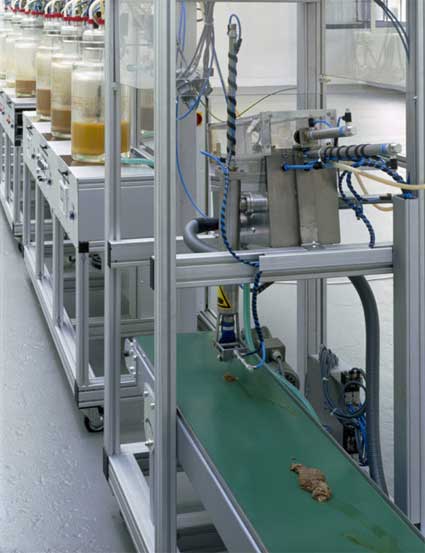
The second version of the machine features an assembly line of parts that each represent a human organ, all distributed on a linear frame to transport food from one function to the next one, just like the real digestive process. Its output is of 200 to 400 gr, that´s the same capacity as the human body. Although it looks impressive, the machine is far from perfect, “even people who never went to school make faeces better than my machines.”
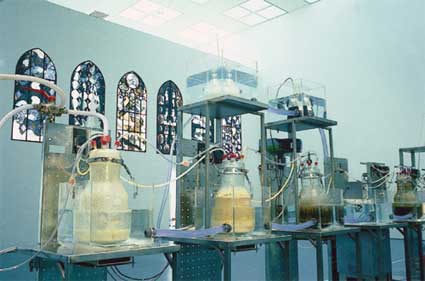
Delvoye also had the Cloaca go through X-ray like a human body would. The challenge was to find a machine which would be big and powerful enough. They located it at Amsterdam Airport and had the Cloaca x-rayed while it throughout its digestive process.
The third machine had a more hard-rock aspect and was built using washing machines. Its particularity is that it has IT connection. So for the birthday of the curator, Delvoye sent an SMS to and instructed the machine to produce diarrhea.
So far 13 museums have shown the pieces but Delvoye never accepted invitations from galleries as he doesn´t want to sell the machines.
The next version, Cloaca Quattro, has a vertical appearance which makes it look like a totem and gives it a more anthropomorphic aspect.
Then came Cloaca Nr. 5, also called the Third World Cloaca, because it is so robust it can never get broken.
The version shown at ars is the personal Cloaca for the home. It looks like a washing machine and actually uses the same enzyme as in washing powder to get the job done. The artist is going to have a solo show in Luxembourg and will then unveal the Super Cloaca, a stainless steel machine which is going to be fed 300 kg of food to generate a massive 80 kg of shit per day.
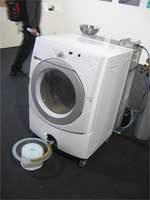
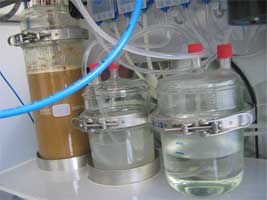
Delvoye is currently trying to set up a Cloaca business in the United States to avoid paying taxes on shit revenues in Belgium. He would get tax exemption in the US if his project is regarded as a church. 2 lawyers are currently investigating what is the best way to establish such church, while the artist is looking for a piece of land to build a temple.
One of Delvoye´s conclusions is that shit itself guarantees that Cloaca is an art piece, it will never be a really successful enterprise.
Images of the installation.







